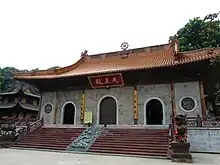Guangji Temple (Wuhu)
Guangji Temple (simplified Chinese: 广济寺; traditional Chinese: 廣濟寺; pinyin: Guǎngjì Sì) is a Buddhist temple located on the southwest hillside of Mount Zhe, in Jinghu District of Wuhu, Anhui, China.[1] Alongside Puji Temple, Nengren Temple and Jixiang Temple, Guangji Temple is known as one of the "Four Buddhist Temples in Wuhu". Guangji Temple has been praised as "Little Mount Jiuhua" (小九华).[2][3] Guangji Temple experienced expansion and repair for many times and now still maintain the basic architectural pattern of the Ming and Qing dynasties (1368–1911).
| Guangji Temple | |
|---|---|
广济寺 | |
 A panoramic view of Guangji Temple. | |
| Religion | |
| Affiliation | Buddhism |
| Deity | Chan Buddhism |
| Leadership | Shi Renyu (释仁煜) |
| Location | |
| Location | Jinghu District, Wuhu, Anhui |
| Country | China |
 Shown within China | |
| Geographic coordinates | 31°20′36″N 118°23′03″E |
| Architecture | |
| Style | Chinese architecture |
| Date established | 894–898 |
History



Tang dynasty
Guangji Temple traces its origins to the a temple built in the Qianning period (894–897) of Tang dynasty (618-907). In the Guanghua period (898–901), it was renamed "Yongqing Temple" (永清寺).[4]
Song dynasty
In the reign of Emperor Zhenzong (1048–1085) in the Song dynasty (960–1276), it was renamed "Guangji Temple" which it still in use now.[4]
Yuan dynasty
In the Yuan dynasty (1368–1644), a poet named Ouyang Yuan (欧阳元) wrote a poem Mount Zhe (《赭山》) to eulogize the beautiful and picturesque landscape of Mount Zhe and Guangji Temple.[4]
Ming dynasty
Guangji Temple was abolished in the Yongle period (1403–1424) of the Ming dynasty (1368–1644) and reactivated its religious activities in the Jingtai period (1450–1456).[4]
Qing dynasty
In 1756, in the period of the Qianlong Emperor of the Qing dynasty (1644–1911), Dai Tianpu (戴天溥) and Wang Zhaohe (汪昭和) donated property to renovate the temple. In 1798, in the reign of Jiaqing Emperor, abbot Yuejiang (越江) repaired the temple. In the Xianfeng period (1850–1861), a fire consumed the temple. The modern temple was rebuilt in the Guangxu period (1874–1908).[4]
People's Republic of China
In 1983 it has been designated as a "National Key Buddhist Temple in Han Chinese Area".[4]
Guangji Temple has been categorized as an AAAA level tourist site by the China National Tourism Administration.
Architecture

Guangji Temple is built along the up and down of Mount Zhe (赭山). Along the central axis are the Hall of Four Heavenly Kings, Hall of Bhaisajyaguru, Mahavira Hall, Hall of Ksitigarbha and the Pagoda.[4]
Hall of Four Heavenly Kings
The Hall of Four Heavenly Kings is also the shanmen of the temple which is the first important hall in Guangji Temple. Maitreya is enshrined in the hall and at the back of his statue is a statue of Skanda. Hengha Erjiang, also known as Nryana, are enshrined in the left and right side of the hall.[4]
Hall of Bhaisajyaguru
The Hall of Bhaisajyaguru is the hall to enshrine Bhaisajyaguru which is the second hall of Guangji Temple.[4]
Mahavira Hall
The Mahavira Hall is the main hall of Guangji Temple. The Three-Life Buddha are enshrined in the temple. The statues of Eighteen Arhats stand on both sides of the hall.[4]
Hall of Ksitigarbha
The Hall of Ksitigarbha is the most important annex halls in Guangji Temple. A 12-metre (39 ft) high statue of Ksitigarbha is placed in the hall, which is magnificent and become the symbol of Guangji Temple. Two standing statues of Min Wen (闵文) and Daoming (道明) are placed on both sides of Ksitigarbha.[4]
References
- 芜湖广济寺中元节举行盂兰盆会 众信徒祭拜祈福 图集. hexun.com (in Chinese). 2015-08-28.
- 芜湖四大名寺:广济寺、普济寺、能仁寺、吉祥寺 [Four Buddhist Temples in Wuhu: Guangji Temple, Puji Temple, Nengren Temple and Jixiang Temple]. baidu.com (in Chinese). 2017-11-12.
- 芜湖千年古刹广济寺 [Millennium Buddhist Temple Guangji Temple in Wuhu]. baidu.com (in Chinese). 2017-08-22.
- 安徽芜湖广济寺(图) [Guangji Temple in Wuhu, Anhui]. sina (in Chinese). 2013-10-17.